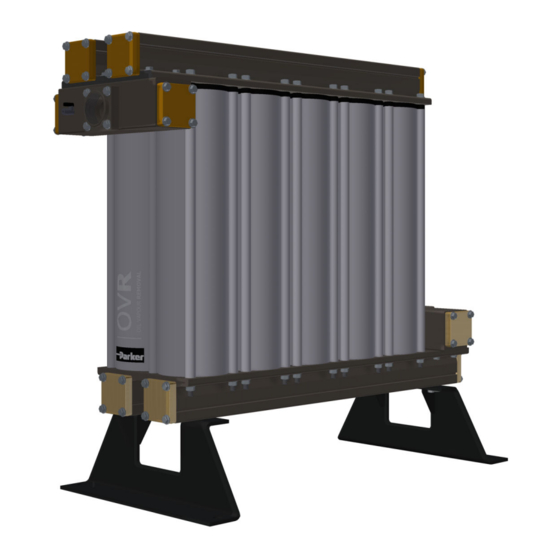
Summary of Contents for Parker OVRP300
- Page 1 Oil Vapour Removal climate control electromechanical OVRP300 - OVRP550 filtration fluid & gas handling User Guide hydraulics pneumatics Original Language process control sealing & shielding...
-
Page 2: Table Of Contents
CONTENTS 1 Safety Information ......................................1 1.1 Markings and Symbols ..................................2 1.2 Model Number Identification ................................2 2 Description ........................................3 2.1 Technical Specification..................................3 2.1 Materials of Construction ..................................4 2.2 Weights and Dimensions ..................................4 2.3 Receiving and Inspecting the Equipment ............................5 2.3.1 Storage......................................5 2.3.2 Unpacking ....................................5 2.4 Overview of the equipment..................................6 3 Installation and Commissioning..................................7... -
Page 3: Safety Information
If the user employs an operating procedure, item of equipment or a method of working which is not specifically recommended by Parker Hannifin the user must ensure that the equipment will not be damaged or become hazardous to persons or property. -
Page 4: Markings And Symbols
1.1 Markings and Symbols The following markings and international symbols are used on the equipment or within this manual: Caution, Read the User Guide. Wear ear protection Highlights actions or procedures which, if not performed Pressurised components on the system correctly, may lead to personal injury or death. -
Page 5: Description
Using the minimum filtration capacity, select an OVR model from the flow rate tables above (OVR selected must have a flow rate 1.00 equal to or greater than the minimum filtration capacity). If the minimum filtration capacity exceeds the maximum values of the models shown within the tables, please contact Parker for 1.00 advice regarding larger multi-banked units. -
Page 6: Materials Of Construction
Nickel plated mild steel Fittings Activated carbon Adsorbent Nitrile, Viton, EPDM, PTFE (tape) Seal materials Epoxy coated, RUCO Black ink 10KK9006 Paint / Ink 2.2 Weights and Dimensions OVRP300 OVRP350 - OVRP550 Dimensions Weight Model OVRP300 39.29 13.9 21.02 11.65 32.99... -
Page 7: Receiving And Inspecting The Equipment
On delivery of the equipment check the crate and its contents for damage, If there are any signs of damage to the crate, or there are any parts missing please inform the delivery company immediately and contact your local Parker office. -
Page 8: Overview Of The Equipment
2.4 Overview of the equipment OVRP300 OVRP350 - OVRP550 Key: Description Description Inlet Manifold OVR Cartridge Outlet Manifold Ball Valve 1/8”... -
Page 9: Installation And Commissioning
Coalescing filters must be installed upstream of the OVR unit (fig 1) to reduce aerosols. These filters do not need to be directly in front of the OVR, they can be part of a purification package in the compressor room. OVR must be protected with Parker OIL-X Grade AO & AA coalescing filters to achieve claimed air purity specification. - Page 10 Fig 1 Fig 2 Fig 3...
-
Page 11: Locating The Equipment
3.2 Locating the Equipment 3.2.1 Environment The equipment should be located indoors in an environment that protects it from direct sunlight, moisture, and dust. Changes in temperature, humidity, and airborne pollution will affect the environment in which the equipment is operating and may impair the safety and operation. It is the customers' responsibility to ensure that the environmental conditions specified for the equipment are maintained. -
Page 12: Operating The Equipment
Operating the Equipment Ensure that the isolation valves on the inlet and the outlet of the unit are closed. Slowly open the isolation valve on the inlet of the unit and verify that there are no leaks. Check that the system pressure relief valve is closed. Test the condensate drains of the filters and ensure they are discharging correctly into a suitable collection vessel. -
Page 13: Servicing
(compressor room) and point of use applications. 5.2 Preventative Maintenance Kits Recommended every 12 months Current Parker Filter Service Kits to be supplied as standard. Please check the filter housing model numbers for correct element suitability. Description... -
Page 14: Ovr Cartridge Replacement
5.3 OVR Cartridge Replacement Close the isolation valves. Slowly open the drain valve on the pre-filter to depressurise the OVR and filters. Move away from the OVR during depressurisation. Whilst supporting the outlet piping, carefully remove the outlet flange from the inlet manifold. - Page 15 SUPPORT SERVICES Parker Support Services are the first port of call for customers in need of help or guidance. The fact that this team is responsible for the production of User Guides and Manuals gives you an insight into the level and detail of their parts and product knowledge.
-
Page 16: Declaration Of Conformity
Declaration of Conformity Parker Hannifin Manufacturing Limited GSFE Dukesway,Team Valley Trading Estate,Gateshead, Tyne & Wear,NE11 0PZ, UK Oil Vapour Removal OVRP 300 (Single Column) & 350, 400, 450, 500 & 550 (Multi Column) 2014/68/EU Directives Generally in accordance with ASME VIII Division 1 :... - Page 17 FR, IE, IL, IS, IT, LU, MT, NL, NO, PL, PT, RU, SE, SK, UK, ZA) Parker Hannifin Manufacturing Limited Catalogue: 174046330 © Parker Hannifin Corporation. All rights reserved. 06/21 Rev: - Gas Separation and Filtration Division EMEA Dukesway, Team Valley Trading Est...














Need help?
Do you have a question about the OVRP300 and is the answer not in the manual?
Questions and answers